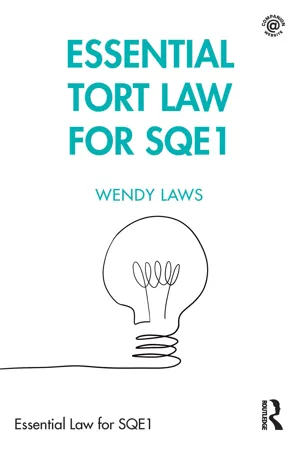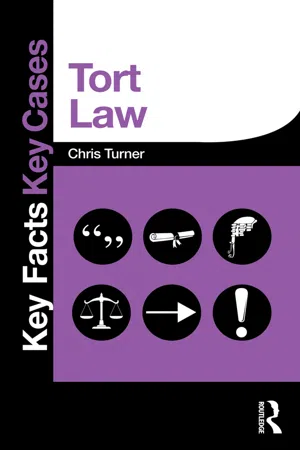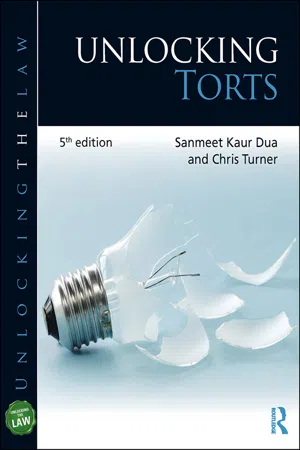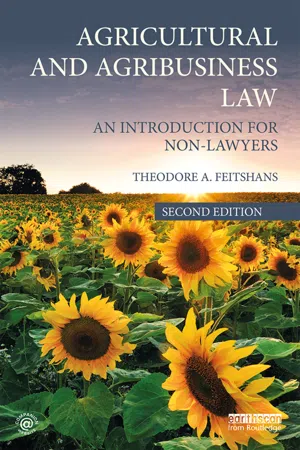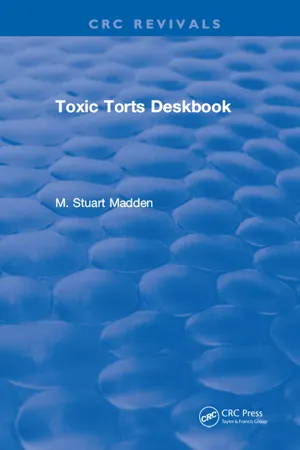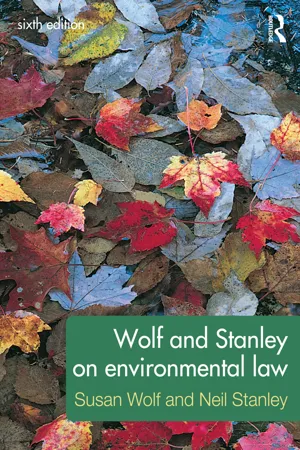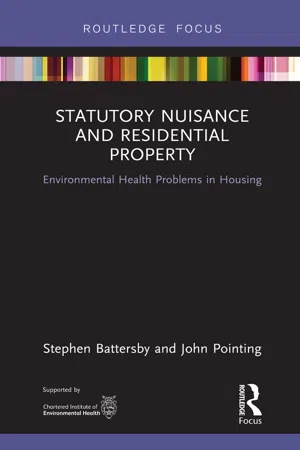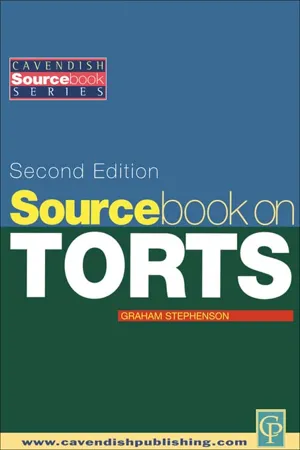Law
Private Nuisance
Private nuisance refers to a legal concept where an individual's use or enjoyment of their property is interfered with by the actions of another party. This interference can include things like excessive noise, odors, or other disturbances. To be considered a private nuisance, the interference must be substantial and unreasonable, and it must cause harm or discomfort to the affected party.
Written by Perlego with AI-assistance
8 Key excerpts on "Private Nuisance"
Learn about this page
Index pages curate the most relevant extracts from our library of academic textbooks. They’ve been created using an in-house natural language model (NLM), each adding context and meaning to key research topics.
- eBook - ePub
- Wendy Laws(Author)
- 2021(Publication Date)
- Routledge(Publisher)
In each of these examples someone is complaining about an interference with their land caused by a conflicting use of their neighbour’s land. They could consider bringing a claim in Private Nuisance. The principles of Private Nuisance are the means by which the law of tort regulates conflicts that arise between neigh-bours over their use of land.The interferences with use and enjoyment of land falling within nuisance can include:- Encroachment – e.g., tree roots growing into neighbouring land
- Tangible damage – e.g., damage to plants by harmful chemicals
- Intangible damage – interference with amenity, such as noise or smells.
- Damages cannot be recovered in Private Nuisance for personal injury.1
1 Where personal injury is suffered, remember to consider the possibility of a claim in negligence.
Private Nuisance provides a remedy for interference with land. So, in order to be able to bring a claim in Private Nuisance:16.3 Who may sue for Private Nuisance? - 5 Nuisance5.1 Private Nuisance5.1.1 The definition, character and purpose of the tort1 Defined as ‘continuous, unlawful and indirect interference with a person’s enjoyment of land or some right over, or in connection with it’.2 It only applies to an ‘indirect’ interference – direct is trespass.3 It concerns prevention more than compensation.4 It concerns the relationship between neighbours.5 There are three key elements to neighbourhood:continuity – involving a recurring state of affairs;people should be free to use their land as they wish, so long as it does not harm their neighbours;neighbours are subject to many trivial disputes, so there is a risk of the courts being flooded with claims.6 Only ‘unreasonable’ interference is a nuisance:so there is no protection against interference classed as reasonable;but if classed as unreasonable it is irrelevant whether it was reasonable for the defendant to engage in such behaviour.7 The test is: what conduct is sufficient to justify legal intervention?8 The court must strike a balance between conflicting interests and this now involves balancing the rights of the individual against that of the wider community even where violation of human rights (Article 8) is involved (Hatton v UK (2003); Dennis v MoD (2003); Marcic v Thames Water Utilities Limited
- eBook - ePub
- Sanmeet Kaur Dua, Chris Turner(Authors)
- 2019(Publication Date)
- Routledge(Publisher)
The tort is essentially concerned with balancing the competing interests of neighbours to make lawful use of their own land. The difficulty is that what may be reasonable to the person carrying out the activity, may be perceived as wholly unreasonable by a neighbour because of the way it interferes with what the neighbours want to do on their land. The courts are left to conduct a balancing act. Only interference which is found by the court to be unreasonable can amount to a Private Nuisance. In considering whether or not the interference is reasonable, the courts will have regard to■ the extent of the harm;■ the nature of the use interfered with.The extent of the harm is judged on the basis of the impact on the claimant. This is judged subjectively. Street gives a good example. A defendant who plays a trumpet very loudly objectively causes a nuisance to a neighbour. It will not be perceived subjectively as a nuisance by a neighbour who is deaf and who is therefore unlikely to hear the noise.The use to which the claimant puts their land is often also relevant to whether he has suffered a nuisance.It will be seen later that the social utility of the defendant’s use of land is only relevant to the remedy which may be awarded.CASE EXAMPLE
Smith v Giddy [1904] 2 KB 448The defendant was liable in nuisance for the branches of trees on his property which overhung the claimant’s land. While this would normally have been an unactionable blockage of light, the fact that the claimant ran a fruit orchard and the interference meant that the fruit trees did not grow properly was decisive in the decision that the defendant was liable.9.3 The parties to an action in Private Nuisance
9.3.1 Who can sue?
Private Nuisance protects interests in and the enjoyment of land. In order to bring an action, the claimant must have a legal interest in the land. This will normally mean a right to exclusive possession by way of freehold or leasehold title. A licensee, for example a lodger or a member of the owner’s family, has no interest in land and cannot therefore bring an action. - eBook - ePub
Agricultural and Agribusiness Law
An Introduction for Non-Lawyers
- Theodore A. Feitshans(Author)
- 2019(Publication Date)
- Routledge(Publisher)
The statutes of limitation for monetary damages are typically shorter than the statutes of limitation for ejectment. Statutes of limitation vary greatly from state to state. The statute of limitation for ejectment is generally the same number of years that are required to acquire property by adverse possession. Acquisition of property by adverse possession will be discussed in Chapter 6. Nuisance A Private Nuisance is a common law tort that is defined as an unreasonable interference by one landowner with another landowner’s use and enjoyment of his or her property. The harm suffered must be substantial. Almost all actions that an owner undertakes on her or his property will in some way interfere with the uses that his or her neighbors make of their property. For that reason, nuisance decisions emphasize the extent to which the defendant’s actions were unreasonable. Examples of unreasonable interferences with a landowner’s use and enjoyment of her real property include smoke, odors, noise or vibration, obstruction of private easements, removal of lateral or subjacent support (causing landslides or subsidence), and interference with riparian rights such as by pollution or diversion of a natural body of water. In most states, if the defendant’s interference involves a physical invasion of the plaintiff’s property the tort is a trespass and not a nuisance. Plaintiffs often allege both trespass and nuisance in their complaint to give courts the option of determining whether the offending actions were a trespass or a nuisance. Theories A Private Nuisance action may be based upon one or more of the three tort theories (intentional, negligence, or strict liability) discussed in Chapter 3 - eBook - ePub
- M. Stuart Madden(Author)
- 2018(Publication Date)
- CRC Press(Publisher)
In contrast, claims that defendant’s conduct creates conditions of noise, lights, odor, or vibration that interfere with plaintiff’s quiet enjoyment of the property ordinarily sound in nuisance. 3 Hence, where plaintiff’s claim involves a physical intrusion upon his property, and where that intrusion is more than a transitory one, plaintiff may plead trespass. Consistent with this general rule, one court distinguished nuisance from trespass on the basis of the duration of the interference. A fleeting or temporary interference with plaintiff’s right to enjoy his property might be categorized as nuisance, while invasion of the property by the same substance or matter, if chronic, or where the contamination was more difficult to eliminate, could be trespass. On this rationale, the court stated that “airborne particles [that are] transitory and quickly dissipate, [and therefore] do not interfere with a property owner’s possessory rights [are] properly denominated nuisances.” 4 4.2 ELEMENTS Private Nuisance may be described as an “unreasonable interference with the use or enjoyment of a property interest.” 5 A toxic intrusion upon the land of a property owner will, therefore, constitute nuisance if it unreasonably interferes with the occupant’s capacity to use, or quietly enjoy, the property. The distinction between “use” and “enjoyment” is not semantic, as some low-level airborne pollution may not altogether prevent an occupant from using his property, but may, nevertheless, interfere with his enjoyment of it, as might a variety of intrusions by odor. 6 At common law, it is generally accepted that “smoke, offensive odors, noise or vibrations” that “materially interfere” with the possessor’s “ordinary comfort” may constitute a nuisance. 7 A toxic nuisance might take a wide range of forms. The pollution of a residence’s well water would interfere both with a resident’s use and enjoyment of a property - eBook - ePub
- Susan Wolf, Neil Stanley(Authors)
- 2013(Publication Date)
- Routledge(Publisher)
25Where there is no actual physical damage to person or property, but only a reduction in the enjoyment of a property (for instance, as a consequence of loud noise or offensive smells), the courts have also indicated that much will depend upon the location where the nuisance is complained of. In the often-quoted case of Sturges v Bridgman (1879),26 Thesiger LJ stated that ‘what would be a nuisance in Belgrave Square would not necessarily be so in Bermondsey’.27 This narrow approach is problematic in the context of environmental protection. Environmental problems often transcend spatially defined areas, and should not be seen in such narrow terms. Moreover, it is precisely in the industrial, urban and run-down areas where there are more likely to be statutory nuisances occurring. There can be no justifiable reason why in these more vulnerable areas the protection of the law should be less than in those areas where the chances of statutory nuisances occurring are more remote.9.3.3 Interference with personal comfortThe common law test for Private Nuisance is that there is an interference to property or the enjoyment of property. However in Wivenhoe Port v Colchester BC (1985),28 the Court of Appeal stated that, in the context of statutory nuisance, nuisance did not have its wide common law meaning but should be confined to personal discomfort. In the judgment, Butler J made the following statement:To be within the spirit of the Act [PHA 1936] a nuisance, to be a statutory nuisance, had to be one interfering materially with the personal comfort of the residents, in the sense that it materially affected their well-being although it might not be prejudicial to their health. Thus, dust falling on motor cars might cause inconvenience to their owners; it might even diminish the value of their motor car; but this would not be a statutory nuisance. In the same way, dust falling on gardens or trees, or on stock held in a shop would not be a statutory nuisance. But dust in eyes or hair, even if not shown to be prejudicial to health, would be so as an interference with personal comfort.29 - eBook - ePub
Statutory Nuisance and Residential Property
Environmental Health Problems in Housing
- Stephen Battersby, John Pointing(Authors)
- 2019(Publication Date)
- Routledge(Publisher)
neighbouring property, though this should not be interpreted as being restricted solely to adjoining property. This conception of Private Nuisance also applies to the nuisance limb of statutory nuisance. In both cases, there is a legal requirement for the problem causing a nuisance to originate on or emanate from one property and to cause harm on neighbouring property.4.04 The tort of Private Nuisance is a civil action giving rights to the owners of property to protection from activities carried out on neigh-bouring property. Besides harmful activities, it may be the condition or state of the property that causes a nuisance to neighbours. A civil action in Private Nuisance would usually be taken in order to obtain an injunction to prevent it from continuing or recurring. It may also include an application for damages: compensation for loss or damage that resulted from the nuisance.4.05 Private Nuisance covers a wider range of interferences to neighbouring land than statutory nuisance. An encroachment onto a neigh-bour’s land by tree roots, causing damage to the foundations of a block of flats was found to be a Private Nuisance in Delaware Mansions .1 But this could not be a statutory nuisance because, firstly, this type of problem does not come within the scope of the statutory nuisances listed in s.79 EPA 1990. But there is also a conceptual reason which limits this problem only to a Private Nuisance action. For a nuisance to come within the scope of statutory nuisance, the harm suffered must interfere with “personal comfort” or be “offensive to the senses” of those occupying or visiting the neighbouring property.2 - eBook - ePub
- Graham Stephenson, Graham Stephenson(Authors)
- 2012(Publication Date)
- Routledge-Cavendish(Publisher)
locus standi to sue for nuisance. What would she be suing for? Mr Brennan QC, who appeared for the [claimants], drew our attention to the rights conferred on a wife with no proprietary interest by the Matrimonial Homes Act 1983. The effect of these provisions is that a spouse may, by virtue of an order of the court upon a break up of the marriage, become entitled to exclusive possession of the home. If so, she will be entitled to sue for nuisance. Until then, her interest is analogous to a contingent reversion. It cannot be affected by a nuisance which merely damages the amenity of the property while she has no right to possession…It seems clear from the above that claims in Private Nuisance are very restricted in what can be recovered and by whom, emphasising that the tort is one concerning the enjoyment of land. Claims for personal injury are to be brought in negligence rather than nuisance. This is thought to prevent anomalies from arising we are told, but is it not anomalous that in this day and age that a spouse or partner (and other permanent members of a household) are held not to have a sufficient interest requiring protection from the nuisance action? What if the person with sufficient interest is temporarily away (for example, working abroad on a long term contract) from the home? Must his/her return be awaited before a nuisance action can be brought?Conduct covered
We shall see that nuisance is concerned with interferences of a physical nature which are indirect, whereas direct physical interferences would be within the scope of a trespass to land action. Nuisance, as we have already seen, however, encompasses more than just physical damage or inconvenience to property. It covers intangible interferences, which can and often are, serious interferences with the use and enjoyment of the claimant's own property. Into this category fall smells, noise, vibrations, for example. Establishing a sex shop or a brothel in a particular area might also be examples of intangible interference. Interference with a view or reception of television signals is not actionable, however.7 There is a tendency, as we shall see, for the law to take the physical interferences more seriously in most situations.Activity or conduct must be unreasonable
This is the crucial issue in any Private Nuisance action. Was the defendant's conduct or activity reasonable in relation to the claimant's use and enjoyment of his own land? There has to be give and take in regard to the use of land, but has the defendant gone beyond this?
